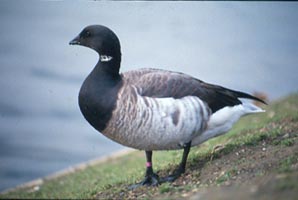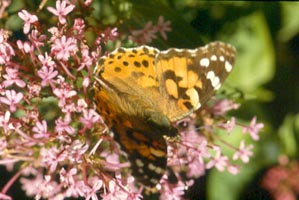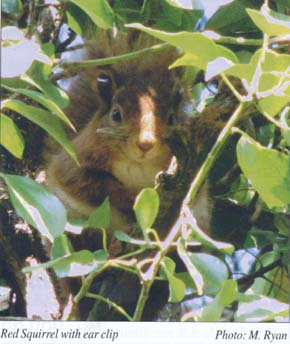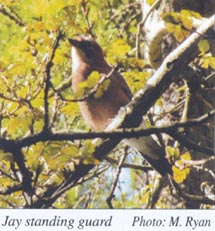| Dalkey Tidy Towns |
  |
| Dalkey Tidy Towns |
  |
|
Wildlife
Newsletter for the Township of Dalkey June 2011 - Michael Ryan |
| DOUBLE BLOW FOR NORTH’S REDS |
|
I
wrote before about Tollymore forest park in County Down where a small (5-9)
number of surviving red squirrels in the forest had their population dramatically
increased by the work of a group of concerned conservationists and local
people. They had trapped and removed alien grey squirrels and supplementary
fed the red squirrels. They had designed and manufactured special feeder
cages which would allow reds in but whose entrance holes were too small
for grey's to get through. Two of those feeders were actually ordered by
DLR and placed on trees on Killiney Hill. The squirrel action group’s
work in Tollymore had increased the number of reds to over100 and was seen
as a very successful example of practical conservation. |
 |
forestry. When we’d been to Tollymore we’d been lucky enough
to meet a woman whose house was actually in the forest. She herself was involved
in the squirrel action group and she very kindly took us in to her garden
where a number of reds hopped along fences and across the lawn to the food
she was providing for them. I sent her an email saying I was sorry to hear
about the outbreak presuming she ‘d have more information. She did
and it wasn’t good at all. The red squirrel that died from SPPV had
actually been found in Tollymore, the first confirmed case in a red squirrel
in Ireland, and to date there had been a total of ten red squirrels found
dead from the virus in the forest. As if that wasn’t bad enough the
forest hadn’t escaped the fires either. The forest fires had destroyed
one complete wood where a good population of reds lived and two other forests
with reds had also been damaged in the area. Almost certainly young squirrels in the dray were probably burnt alive and potential future food from the trees would have been destroyed which is a very depressing thought. To counteract the threat of SPPV infection they’ve removed the feeders to prevent cross infection between the reds. As our friend, Jeanette says ‘We just have to do what we can and get on with it - we are still seeing healthy reds which is very encouraging’. Very best of luck to them, after all the work they’ve done to help the squirrels it seems very tough and must be very disheartening that they should receive this double blow. Incidentally this is the centenary year of grey squirrels introduction into Ireland when six pairs were given as a wedding present to the Earl of Granard in Longford. Little did they know that their very novel present would be devastating native wildlife one hundred years later. Locally I’d seen a red squirrel on Killiney which had a big tuft of fur missing from it’s tail. Didn’t know if it had been attacked by a predator, maybe a close encounter with a dog or cat or had it been involved in a bizarre accident. Subsequently the only red squirrels we saw on the hill seemed to be the damaged tail one and I was wondering was it the only red left. I contacted one of the researchers to tell him and was glad to hear that they had actually trapped three red squirrels in the wood, taken DNA samples and then had cut the hair from their tails for identification. They’d also put clips on their ears which can be seen in the photo. The handling was kept to a minimum and wouldn’t have done the squirrels any harm. |
|
THE
JAY WAY |
|
|
Last
year on Dalkey Hill my sharp eyed companion had seen a Jay going into a tree
evidently to its nest and subsequently we could actually see the almost fledged
we young birds spilling out over the side of the nest. If hadn’t seen
it last year I wouldn’t have known the birds had actually returned
to the same nest this year. Although close to a path the nest is very difficult
to see and they are very secretive birds at the best of times but we have
seen what is presumably the male jay who stands guard nearby and occasionally
brings in food to his mate sitting on the nest. The jays call is quite a
raucous sound but we could hear this bird as it perched nearby producing
a great array of low sounds, some almost melodic, as if it was communicating
with its mate in the nest. It stays very inconspicuous but will launch itself
at anything that threatens |
 |
|
the nest. We’ve seen him driving off magpies as well as hooded crows
and sparrowhawks all birds that might threaten their chicks. Jays have nested
successfully on the hill for the last two years producing four or five young
each time so fires, humans and predators withstanding they might be successful
again this year. |
| DALKEY’S SUMMER BIRDS |
|
|
Their
numbers have crashed nationwide in recent years but there seems to be quite
a few Song Thrushes around this year and there are at least three singing
on Dalkey Hill where they hadn’t held territory in previous years.
We used have Dawn Chorus outings on Dalkey Hill during the 90s and although
we might hear song thrushes singing from across the road from someone’s
garden we never had any in the woods of the park, so for whatever reason
they’re now on Dalkey and Dalkey hills they’re very welcome.
Song thrushes are one of our most dramatic songsters whose strident calls
are often the last bird song coming out of the dusk on warm spring or summer
nights. Blackcaps are summer migrants (the ones that come to our gardens in winter are from eastern Europe) and they seem to be doing very well as a species which is reflected in our own locality with good numbers singing on the hills, usually from dense cover, although one has been singing from a tree on the path up to the Telegraph Tower. Other summer migrants of the warbler family, Chiffchaffs and Willow Warblers are plentiful in the woods as well. |
Almost
every year another summer migrant warbler from Africa the much scarcer Whitethroat
sings from the trees and bushes between the Vico Road and the railway line.
Sure enough he appeared this year in the usual places, his fast bursts of
song tracing him from bush to treetop. Maybe no females had arrived at his
previous location but early in May he was singing from the top of Dalkey
Hill. You’d hope after flying over 3,000 miles from his wintering grounds
in Sub Saharan Africa he’d be able to find a mate and raise a family.
The song thrushes larger relative is the Mistle Thrush and we saw a pair
in the woods on Dalkey hill attempting to build a nest in three different
locations all of which they subsequently abandoned. They’re one of
the few songbirds which make nests which are quite visible, often in the
fork of large trees, relying on their size and ferocity to defend it. They
were still around at time of writing so hopefully they found a suitable site.
By comparison Treecreepers make nests in the tiniest of cracks or behind
the bark of trees, sometimes in conifers although a pair on Dalkey were nesting
in a very large beech tree behind a split in the main trunk which looked
like the safest possible location any bird could nest in. |
